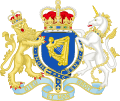Secretary of State (Ireland) facts for kids
Quick facts for kids IrelandSecretary of State |
|
|---|---|

Coat of Arms of the Kingdom of Ireland from 1542 to 1800
|
|
| Member of | Privy Council of Ireland |
| Seat | Dublin Castle, Dublin |
| Appointer | Chief governor of Ireland |
| Term length | No fixed term |
| Formation | 1560–1801 |
| First holder | John Challoner |
| Final holder | Charles Abbot, 1st Baron Colchester |
The Principal Secretary of State was an important government job in the old Kingdom of Ireland. This role was ended in 1801. That's when Ireland joined with Great Britain to form the United Kingdom of Great Britain and Ireland. This change happened because of laws called the Acts of Union 1800.
This job was created in May 1560. It was set up by the Lord Deputy of Ireland, Thomas Radclyffe, 3rd Earl of Sussex. The Lord Deputy was like the main ruler of Ireland for the English King or Queen. He wanted to make English rule stronger in Ireland. This was part of a bigger plan called the Tudor conquest of Ireland.
The job was similar to the Secretary of State in England. It was meant to be a special role, different from other helpers. Over time, the job changed. But at first, the person in this role was expected to:
- Lead meetings of the Privy Council of Ireland. This was a group of advisors to the ruler.
- Write many letters to the King or Queen in England.
Other things the Secretary of State sometimes did included:
- Giving directions to other helpers in the Privy Council.
- Giving advice to the chief governor of Ireland. This governor was either the Lord Deputy or later the Lord Lieutenant.
Over time, this job became less powerful. Other officials, like the Chief Secretary for Ireland, started handling more of the important work. The last three people to hold this job also had the more important role of Chief Secretary. No new Secretary of State was chosen after the Acts of Union in 1800. The very last person to hold the job left it in 1802. He became the Speaker of the UK House of Commons.
Who Held the Job?
This is a list of some of the people who were the Principal Secretary of State for Ireland:
- By 1576: John Chalenor
- 1581: Sir Geoffrey Fenton
- 1603: Sir Richard Cooke
- 1612: Sir Dudley Norton
- 1616: Francis Annesley, 1st Baron Mountnorris
- 1634: Philip Mainwaring
- 1661: Sir Paul Davys
- 1665: George Lane, 1st Viscount Lanesborough
- 1678: Sir John Davys
- 1690: Sir Robert Southwell
- 1702: Edward Southwell Sr.
- 1730: Edward Southwell Jr.
- 1744: William Lingent Esqr.
- 1755: Thomas Carter
- 1763: Philip Tisdall
- 1766: John Hely-Hutchinson (he took over in 1777)
- 1796: Thomas Pelham
- During Pelham's time, Baron Glentworth (1795–97) and Lord Castlereagh (1797–1801) held another important role. This was the Keeper of the Signet or Privy Seal of Ireland.
- 1801: Charles Abbot (he left the job in 1802 to become Speaker of the UK Commons)
Related Topics
- Privy Council of Ireland
- Chief Secretary for Ireland
- Secretary of State (United Kingdom)

